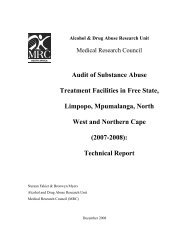Access to substance abuse treatment in the Cape Town metropole ...
Access to substance abuse treatment in the Cape Town metropole ...
Access to substance abuse treatment in the Cape Town metropole ...
You also want an ePaper? Increase the reach of your titles
YUMPU automatically turns print PDFs into web optimized ePapers that Google loves.
illegally and are unregulated by <strong>the</strong> state. Although private non-profit facilities arerelatively more accessible <strong>to</strong> HDCs than for-profit services, <strong>the</strong> quality of servicesprovided by <strong>the</strong>se facilities is often variable and wait<strong>in</strong>g lists at <strong>the</strong> betterresourced facilities are often lengthy. In addition, many of <strong>the</strong> accredited nonprofitfacilities require clients <strong>to</strong> make some form of f<strong>in</strong>ancial contribution <strong>to</strong>wards<strong>the</strong>ir <strong>treatment</strong> (Myers, 2004b). Quality of services, wait<strong>in</strong>g lists, and co-paymentfees may all restrict access <strong>to</strong> <strong>treatment</strong> for persons from HDCs.1.5. PRIOR RESEARCH AND THE WAY FORWARDTo date, plann<strong>in</strong>g and decision-mak<strong>in</strong>g around <strong>substance</strong> <strong>abuse</strong> <strong>treatment</strong> <strong>in</strong> <strong>the</strong><strong>Cape</strong> <strong>Town</strong> <strong>metropole</strong> has been hampered by a lack of accurate <strong>in</strong>formation on<strong>substance</strong> <strong>abuse</strong> <strong>treatment</strong> need, patterns of service delivery, and patterns of<strong>treatment</strong> utilization (Myers & Parry, 2005). Substance <strong>abuse</strong> <strong>treatment</strong> servicesresearch (which could address this issue) has been characterised by a largelydescriptive focus on (i) <strong>the</strong> extent <strong>to</strong> which <strong>treatment</strong> centres are used by clientsfrom his<strong>to</strong>rically disadvantaged population groups and (ii) <strong>the</strong> extent <strong>to</strong> which<strong>treatment</strong> facilities target fac<strong>to</strong>rs thought <strong>to</strong> be barriers <strong>to</strong> service utilization(Myers, 2004a; Myers, 2004b; Myers & Parry, 2002). This early research hasseveral limitations. Firstly, as it has not compared recipients of services withcommunity-based samples of untreated <strong>substance</strong> users, it has been difficult <strong>to</strong>identify fac<strong>to</strong>rs that facilitate or restrict access <strong>to</strong> <strong>treatment</strong>. This has hampered<strong>the</strong> development of <strong>in</strong>terventions <strong>to</strong> improve access for under-served groups.Secondly, previous studies have tended <strong>to</strong> extrapolate f<strong>in</strong>d<strong>in</strong>gs from developedcountries and apply <strong>the</strong>m directly <strong>to</strong> <strong>the</strong> South African context. As <strong>the</strong> fac<strong>to</strong>rsthat enable and restrict access <strong>to</strong> <strong>substance</strong> <strong>abuse</strong> <strong>treatment</strong> among his<strong>to</strong>ricallydisadvantaged communities <strong>in</strong> South Africa have not been directly exam<strong>in</strong>ed, <strong>the</strong>degree <strong>to</strong> which f<strong>in</strong>d<strong>in</strong>gs from developed country sett<strong>in</strong>gs can be extrapolated <strong>to</strong><strong>the</strong> South African context rema<strong>in</strong>s unclear. This is cause for concern as <strong>the</strong>identification of locally-relevant environmental and contextual barriers is essentialfor <strong>the</strong> development of <strong>in</strong>terventions that are <strong>the</strong>oretically sound, acceptable <strong>to</strong>,12
















